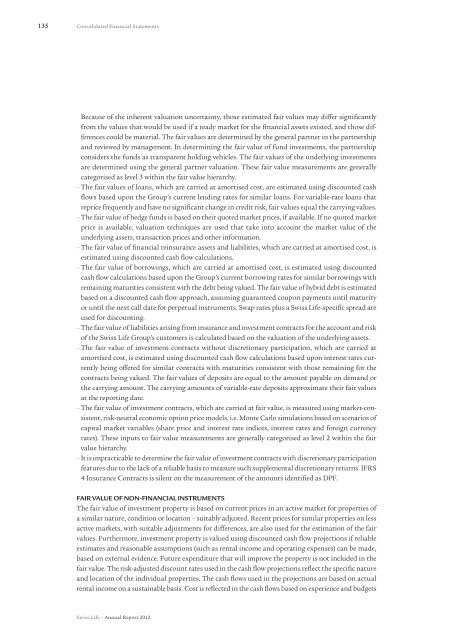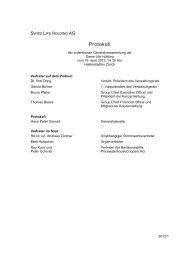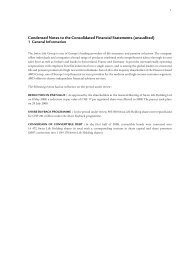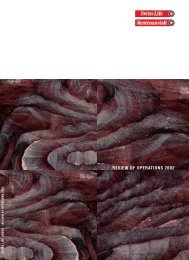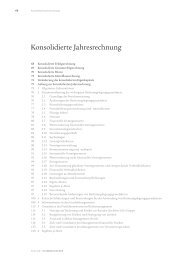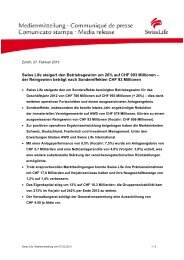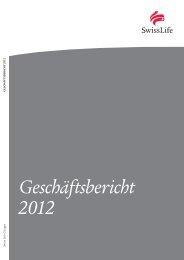Annual Report 2012 - Swiss Life
Annual Report 2012 - Swiss Life
Annual Report 2012 - Swiss Life
Create successful ePaper yourself
Turn your PDF publications into a flip-book with our unique Google optimized e-Paper software.
135 Consolidated Financial Statements<br />
Because of the inherent valuation uncertainty, those estimated fair values may differ significantly<br />
from the values that would be used if a ready market for the financial assets existed, and those differences<br />
could be material. The fair values are determined by the general partner in the partnership<br />
and reviewed by management. In determining the fair value of fund investments, the partnership<br />
considers the funds as transparent holding vehicles. The fair values of the underlying investments<br />
are determined using the general partner valuation. These fair value measurements are generally<br />
categorised as level 3 within the fair value hierarchy.<br />
– The fair values of loans, which are carried at amortised cost, are estimated using discounted cash<br />
flows based upon the Group’s current lending rates for similar loans. For variable-rate loans that<br />
reprice frequently and have no significant change in credit risk, fair values equal the carrying values.<br />
– The fair value of hedge funds is based on their quoted market prices, if available. If no quoted market<br />
price is available, valuation techniques are used that take into account the market value of the<br />
underlying assets, transaction prices and other information.<br />
– The fair value of financial reinsurance assets and liabilities, which are carried at amortised cost, is<br />
estimated using discounted cash flow calculations.<br />
– The fair value of borrowings, which are carried at amortised cost, is estimated using discounted<br />
cash flow calculations based upon the Group’s current borrowing rates for similar borrowings with<br />
remaining maturities consistent with the debt being valued. The fair value of hybrid debt is estimated<br />
based on a discounted cash flow approach, assuming guaranteed coupon payments until maturity<br />
or until the next call date for perpetual instruments. Swap rates plus a <strong>Swiss</strong> <strong>Life</strong>-specific spread are<br />
used for discounting.<br />
– The fair value of liabilities arising from insurance and investment contracts for the account and risk<br />
of the <strong>Swiss</strong> <strong>Life</strong> Group’s customers is calculated based on the valuation of the underlying assets.<br />
– The fair value of investment contracts without discretionary participation, which are carried at<br />
amortised cost, is estimated using discounted cash flow calculations based upon interest rates currently<br />
being offered for similar contracts with maturities consistent with those remaining for the<br />
contracts being valued. The fair values of deposits are equal to the amount payable on demand or<br />
the carrying amount. The carrying amounts of variable-rate deposits approximate their fair values<br />
at the reporting date.<br />
– The fair value of investment contracts, which are carried at fair value, is measured using market-consistent,<br />
risk-neutral economic option price models, i.e. Monte Carlo simulations based on scenarios of<br />
capital market variables (share price and interest rate indices, interest rates and foreign currency<br />
rates). These inputs to fair value measurements are generally categorised as level 2 within the fair<br />
value hierarchy.<br />
– It is impracticable to determine the fair value of investment contracts with discretionary participation<br />
features due to the lack of a reliable basis to measure such supplemental discretionary returns. IFRS<br />
4 Insurance Contracts is silent on the measurement of the amounts identified as DPF.<br />
Fair value of non-financial instruments<br />
The fair value of investment property is based on current prices in an active market for properties of<br />
a similar nature, condition or location – suitably adjusted. Recent prices for similar properties on less<br />
active markets, with suitable adjustments for differences, are also used for the estimation of the fair<br />
values. Furthermore, investment property is valued using discounted cash flow projections if reliable<br />
estimates and reasonable assumptions (such as rental income and operating expenses) can be made,<br />
based on external evidence. Future expenditure that will improve the property is not included in the<br />
fair value. The risk-adjusted discount rates used in the cash flow projections reflect the specific nature<br />
and location of the individual properties. The cash flows used in the projections are based on actual<br />
rental income on a sustainable basis. Cost is reflected in the cash flows based on experience and budgets<br />
<strong>Swiss</strong> <strong>Life</strong> – <strong>Annual</strong> <strong>Report</strong> <strong>2012</strong>


